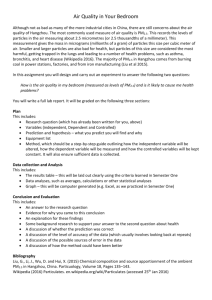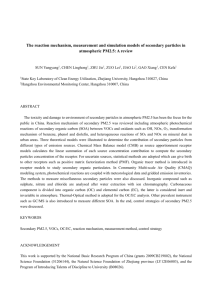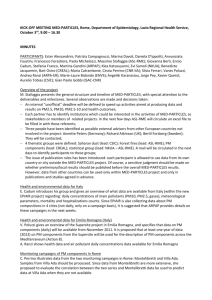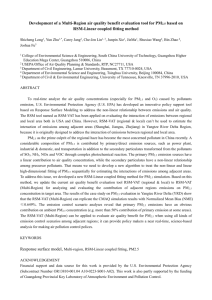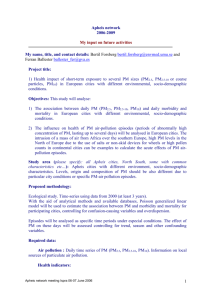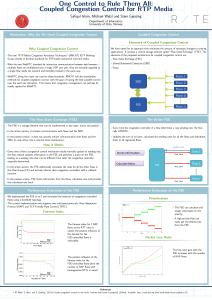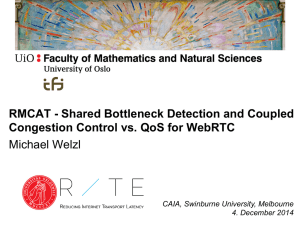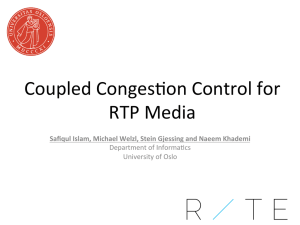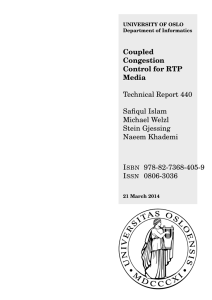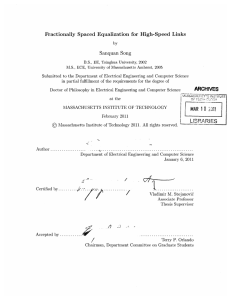Urban vs. Rural Atlanta
advertisement
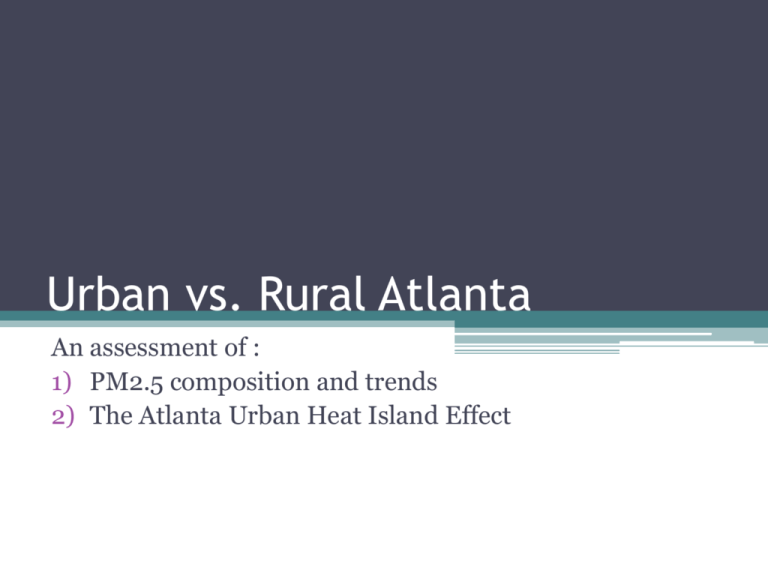
Urban vs. Rural Atlanta An assessment of : 1) PM2.5 composition and trends 2) The Atlanta Urban Heat Island Effect Outline • Part I: PM2.5 Compositional analysis and trends ▫ ▫ ▫ ▫ ▫ ▫ Background Assessment Composition Spatial and temporal Analysis Monthly Analysis Meteorological Correlations • Part II: Urban Heat Island Index and Effect ▫ Background ▫ Diurnal UHI in urban vs. rural environment ▫ Meteorological Correlations • Part III: Conclusions Part I: PM2.5: Why are we so concerned? • Aerosols • PM ▫ Environmental Issues ▫ Health Risks • PM2.5 ▫ Humans inhale it ▫ It diffuses • Primary and secondary origin ▫ Formation poorly understood PM Assessment 2.5 • Part of Georgia Tech’s ASACA project • 3 sites ▫ Fire Station 8 (FSE) (urban) (Daily) ▫ South Dekalb (SD) (urban) (Daily) ▫ Yargo (YG) (rural) (1 in 3 days) • 3 filter types ▫ Quartz (EC/OC analysis) ▫ Nylon (wsioi and ions) Na+, NH4+,K+,Ca2+,Cl-, NO2-, NO3-, SO42- , CH3COO-, HCOO-, C2O42- ▫ Teflon (trace metals) • PCM, IC, TOT, TEOM, aeth. • Only 2012 data analyzed Figure 1: Map of the three different sampling sites. A: Fort Yargo State Park, B: Fire Station Eight, C: South Dekalb site PM Composition in 2012 2.5 PM2.5 Analysis: Spatial and temporal 12 25 10 20 8 15 6 10 4 5 2 0 0 10 20 FSE_PM2.5 30 SD_PM2.5 40 50 0 0 10 20 YG_PM25. 30 FSE_OC 3 40 SD_OC 50 YG_OC 4.5 4 2.5 3.5 2 3 2.5 1.5 2 1 1.5 1 0.5 0.5 0 0 0 10 20 FSE_EC 30 SD_EC 40 YG_EC 50 0 10 20 FSE_SO4 30 SD_SO4 40 YG_SO4 50 PM2.5 Analysis: Spatial and temporal 1.4 1.4 1.2 1.2 1 1 0.8 0.8 0.6 0.6 0.4 0.4 0.2 0.2 0 0 0 10 20 FSE_NH4_Avg 30 SD_NH4_Avg 40 50 0 YG_NH4_Avg 10 20 FSE_NO3 30 SD_NO3 40 YG_NO3 4.5 4 3.5 3 2.5 R Square Adjusted R Square 0.833 Standard Error 0.189 0.826 2 1.5 1 Coefficients Standard Error 0.5 0 0 10 20 FSE_SO4 30 SD_SO4 40 YG_SO4 50 P-value Intercept 0.408 0.110 0.0011 X Variable 1 2.711 0.242 3.35E-11 50 PM Analysis: Monthly 2.5 Average OC (microg/m3) 9 8 7 6 5 4 3 2 1 0 2.5 0 Average Sulfate (ug/m3) 2012 Monthly OC Average 2 SD YG FSE 2 4 6 Month 8 10 SD YG 1 0 14 FSE 1.5 0.5 12 2012 Monthly Sulfate Average PM2.5 Analysis: Meteorological Correlations 40 35 30 25 Avg T (deg C) 20 FSE_PMSpec 15 10 5 0 11/3/2011 -5 12/23/2011 2/11/2012 4/1/2012 5/21/2012 7/10/2012 8/29/2012 10/18/2012 12/7/2012 1/26/2013 70 60 Avg Windspeed (km/hr) 50 40 FSE_PMSpec 30 20 10 0 11/3/2011 12/23/2011 2/11/2012 4/1/2012 5/21/2012 7/10/2012 8/29/2012 10/18/2012 12/7/2012 1/26/2013 PM2.5: Meteorological Correlations Avg Temp (deg C) - YG y = 0.3956x + 14.683 R² = 0.0717 35 30 25 20 Avg Temp (deg C) 15 Linear (Avg Temp (deg C)) 10 5 Regression Statistics R Square Adjusted R Square Standard Error 0.0717 0.0643 4.727 Coefficients Standard Error P-value Intercept 6.0758 1.148 5.19E-07 X Variable 1 0.181 0.058 0.00225 0 0 10 20 30 Avg Windspeed (km/hr) - SD 40 35 y = -0.8552x + 12.322 R² = 0.1202 30 25 Avg Windspeed SD 20 15 Regression Statistics R Square Adjusted R Square Standard Error Linear (Avg Windspeed SD) 10 5 0 0 5 10 15 Intercept X Variable 1 0.12 0.118 4.785 Coefficients Standard Error P-value 12.322 -0.855 0.489 0.121 9.49E-82 8.92E-12 Part II: Urban Heat Island Index and Effect • Urban Area Temperature > Rural Area Temperature ▫ Population density, geography, building structure and material, vegetation ▫ Urban cities trap radiation near the surface Large differences in solar radiation and heat and water balances UHII 15 UHI 10 5 0 11/3/2011 -5 12/23/2011 2/11/2012 4/1/2012 5/21/2012 7/10/2012 8/29/2012 10/18/2012 12/7/2012 1/26/2013 Urban Atlanta Albedo Diurnal UHI in Urban vs Rural Sites January 16 May 1 February 16 November 7 UHII vs Meteorological Correlations Rel Windspeed 14 y = -0.14x + 6.0322 R² = 0.1146 12 10 Rel Windspeed 8 6 Linear (Rel Windspeed) 4 2 0 -10 -2 0 10 20 y = -0.0872x + 3.7069 R² = 0.2378 8 6 2 0 -40 -20 -2 Coefficients Intercept X Variable 1 6.032 -0.14 Adjusted R Square 0.236 Standard Error 1.910 Standard Error 0.1133 0.0204 P-value 6.95E-174 2.92E-11 Coefficients Standard Error P-value Intercept 3.707 0.2194 1.15E-47 X Variable 1 -0.0872 0.00819 2.93E-23 Rel. Humidity 4 -60 2.059 Regression Statistics 14 10 0.112 30 Rel. Humidity 12 Regression Statistics Adjusted R Square Standard Error 0 20 To sum up… • PM2.5 is of concern in both urban and rural Atlanta ▫ Although composition similar, concentrations need to be monitored ▫ Meteorological factors play a big role • Atlanta is a hub for UHI ▫ More attention needed in diurnal changed in meteorological patterns • A lot can change in a small distance! Special Thanks to • 2012 - 2013 ASACA team ▫ Jeremiah Redman ▫ Kyle Digby ▫ Boris Galvis References • Bell, et al. "Spatial and Temporal Variation in PM2.5 Chemical Composition in the United States for Health Effects Studies." Environmental Health Perspectives: n. pag. Print. • Chow, et al. "PM2.5 chemical composition and spatiotemporal variability during the California Regional PM10/PM2.5 Air Quality Study (CRPAQS)." Journal of Geophysical Research Atmospheres: n. pag. Print. • Clarke, Azadi-Boogar, and Andrews. "Particle size and chemical composition of urban aerosols." Science of the Total Environment: n. pag. Print. • Kim. "Urban Heat Island." International Journal of Remote Sensing 13.12 (1992): n. pag. Print. • Myrup. "A Numerical Model of the Urban Heat Island." American Meteorology Society: n. pag. Print. • Myrup, Leonard. "A Numerical Model of Urban Heat Island." Journal of Applied Meteorology: n. pag. Print. • The Urban Environment. N.p., n.d. Web. 24 Apr. 2013. <http://www.coa.gov.in/mag/Archi_Apr09Lowres-pdf/20-25-Urban%20heat%20island.pdf>. • Weng, Lu, and Schubring. "Estimation of land surface temperature–vegetation abundance relationship for urban heat island studies." Remote Sensing of Environment 89.4 (2004): n. pag. Print. Any questions? Thanks for listening!

